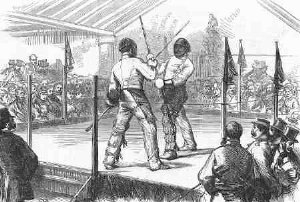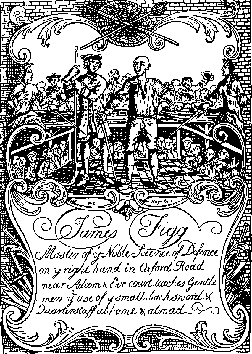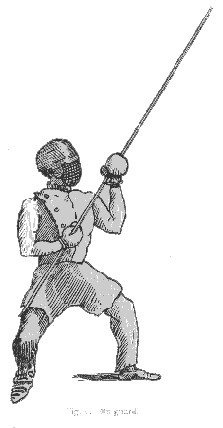What's New - Timeline - Articles - Techniques - Catalog - Seminars - Links - Contact Us
The Manly Art of Quarter-Staff
Origins of a Victorian Combat Sport
By Tony Wolf

A quarterstaff match in
1870

A quarterstaff match in
1870
The late Victorian era was a time of exploration
and innovation in many fields, including the arts of self defence.
Wrestling in various regional styles and boxing according to the
rules of the London Prize Ring (later the Marquis of Queensberry
Rules) were immensely popular spectator sports. The merits of newly
introduced methods such as French Savate and la Canne, Japanese
Jiu-jitsu and the English adaptation, "Bartitsu", were
enthusiastically debated in newspaper and magazine articles. British
soldiers were still trained in combat with weapons such as the
bayonet and cavalry sabre, and research into antique methods of
swordplay was undertaken to improve their skills. In many ways, the
period between 1870 - 1900 was a Golden Age of close-combat.
The Victorian English penchant for the "manly arts" also included
quarterstaff fencing. In this sport, players wearing fencing uniforms
and protective armour competed for points by sparring with
lightweight staves, typically up to eight feet in length. Two manuals
detailing the rules and techniques were produced; Sergeant Thomas
McCarthy's "Quarter-Staff" in 1883, and a chapter of "Broadsword and
Singlestick" by R.G. Allanson-Winn in 1898. In the early 1900s,
quarterstaff fencing was taken up by members of the Boy Scout
movement, who produced a simplified manual for training towards their
"Master at Arms" badge.
This essay attempts to trace the origins and development of this
uniquely English combat sport.
In his "Paradoxes of Defence" (1599), the English
Master-at-Arms George Silver wrote:
The Short Staffe is most commonly the best weapon of all other, although other weapons may be more offensive, and especially against many weapons together, by reason of his nimbleness and swift motions, and is not much inferior to the Forest Bille, although the Forest Bille be more offensive, the Short Staffe will prove the better weapon.
|
The quarterstaff was closely identified
with sport and civilian self-defence, as a weapon of
expedience used by travellers or in formal duels. By the
early 1700s the weapon was commonly employed in public
prize-fights, with the winner receiving both gate-money and
the proceeds of wagering. The famed English stage gladiator
James Figg promoted the art, along with backswording and
pugilism, in bouts at Southwark Fair, and after his
retirement from the stage in 1735 he taught it to young
aristocrats at his own School of Arms in London's Oxford
Street. |
 |
In this essay, I suggest that the sport of
quarterstaff fencing as practised between 1870 and 1898 was not a
direct, lineal continuation of the traditional art, but rather a
Victorian innovation or reconstruction drawing upon three main
influences. These included the widespread availability of bamboo, the
boom in sporting equipment manufacture, and the popularity of the
Robin Hood legends. Bamboo was introduced into England around
1827. Bamboo poles were light enough that players could
strike to the body at full speed and risk only a welt or
bruise, and a slender eight-foot length was flexible enough
to absorb impact without splitting. British cavalrymen
employed bamboo training weapons in lance manoeuvres,
following the example of Indian soldiers they encountered
during the "Raj" period, beginning in 1858, and bamboo
quarterstaves are recommended in all of the surviving
Victorian-era manuals. Even armed with lightweight bamboo
weapons, the knees and shins, groin, hands, temples, throat,
and eyes were still vulnerable to serious, even if
accidental, injury. By 1870, however, amateur quarterstaff
fencers could choose from a diverse range of protective
equipment designed for other sports. By the late 1860s gladiatorial stage
combats were a thing of distant memory, and the quarterstaff
was most widely associated with the legendary outlaw hero of
Sherwood Forest.
The traditional English staff was a sturdy weapon of oak or similar
hardwood, difficult to manoeuvre with any regard for a sparring
partner's safety. It's important to remember that Figg and his
contemporaries were professional fighters, willing to risk injury in
un-armoured, full-contact bouts with weapons (although it was
suspected at the time that some professionals fixed their fights, in
the manner of modern pro-wrestlers.) The danger of fencing with oak
staves may have dissuaded amateurs from taking up the art
recreationally, in contrast to the gladiators who fought to earn
their living.
As Britain entered the Industrial Age, there arose a
relatively affluent urban middle-class with time to pursue
sports and other diversions. Supply meets demand, and the
first sporting equipment companies were established, leading
to a rapid evolution in sporting equipment design and
manufacture.

McCarthy Guard
Stance

Allanson-Winn
Guard
Between 1820 - circa 1850, the mask used by fencers (more
accurately, "foilists") had been a simple wire mesh screen
across the face. In response to the demands of heavier
weapons such as the singlestick and training bayonet, mask
designs began to incorporate hardened leather panels to
protect the top and sides of the head, or helmet attachments
woven out of strong wicker. The facial mesh was strengthened
and reinforced with an internal framework of heavy wire that
reduced denting and the chances of penetration. By the 1880s
the Army had commissioned the "military broadsword helmet"
for use in training cavalry soldiers, with additional
protection for the back of the head. This design is
recommended in both the McCarthy and Allanson-Winn
quarterstaff texts.
Broadsword (military sabre) fencers developed padded leather aprons
in a variety of styles, providing some degree of protection to the
groin area and effectively padding the thighs against cutting
attacks. At about the same time, new knee and shin guards,
constructed out of bamboo strips backed with padding, were invented
for the sport of cricket. Finally, the widespread availability of
commercially manufactured boxing gloves allowed a measure of hand and
finger protection beyond the requirements of sword fencers, but ideal
for quarterstaff players whose weapons lacked guards.
Victorian England was in the grip of Robin Hood fever, and
hundreds of books, songs, plays and poems were produced,
commemorating and elaborating his adventures.
A key incident in these stories, instantly familiar even
today, is Robin Hood's quarterstaff match with Little John,
taking place on a bridge over a shallow stream.
It is not unlikely that the recreational quarterstaff play
of the later Victorian period was influenced as much by the
popularity of the Robin Hood legends as by the memory of
Figg and his peers fighting on the stage at Southwark
Fair.

Tragically, many young English athletes gave up
their lives in the trenches of the First World War, and the
generation that might otherwise have perpetuated the new sport of
quarterstaff fencing was all but lost. Many other Victorian-era
combat arts and sports were similarly afflicted, some experiencing a
brief revival in the 1920s (such as quarterstaffing as practised by
the Boy Scouts) before finally succumbing during the Great Depression
and then World War Two. Similarly, the homogenising effect of the
international Olympic movement caused many obscure sports to fade
from memory through lack of publicity and funding. It is only in
comparatively recent years that these activities have been researched
and, in some cases, brought tentatively back to life.